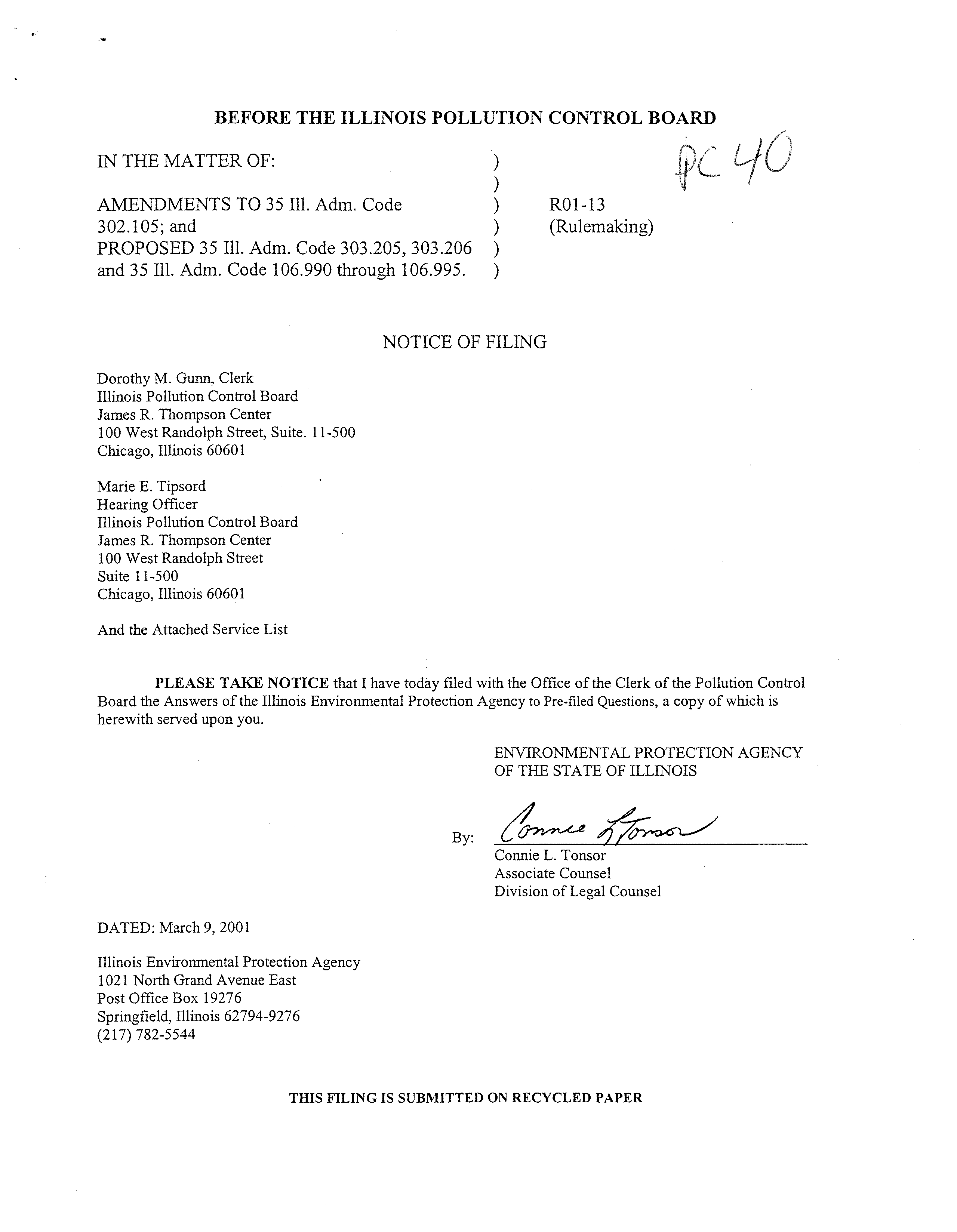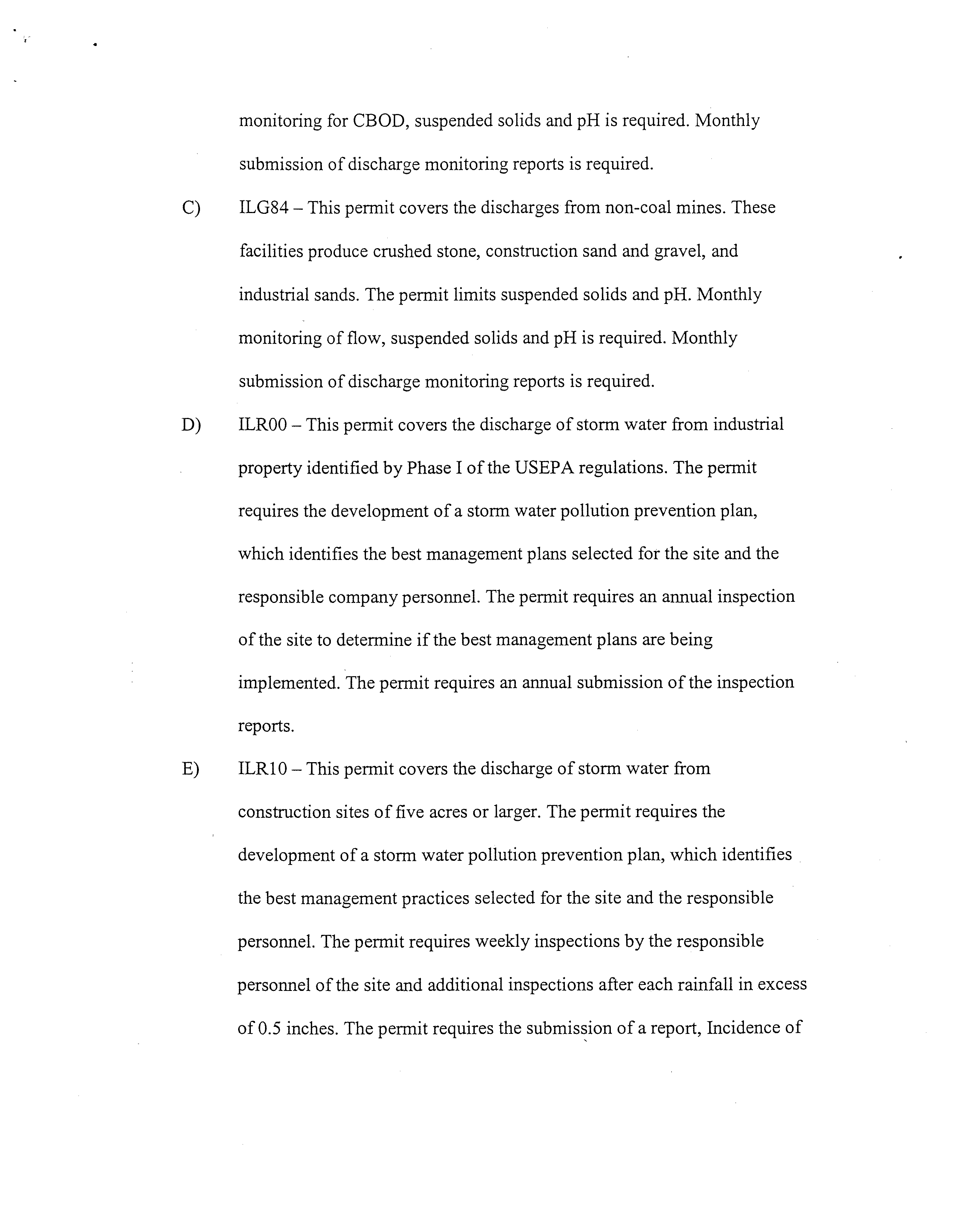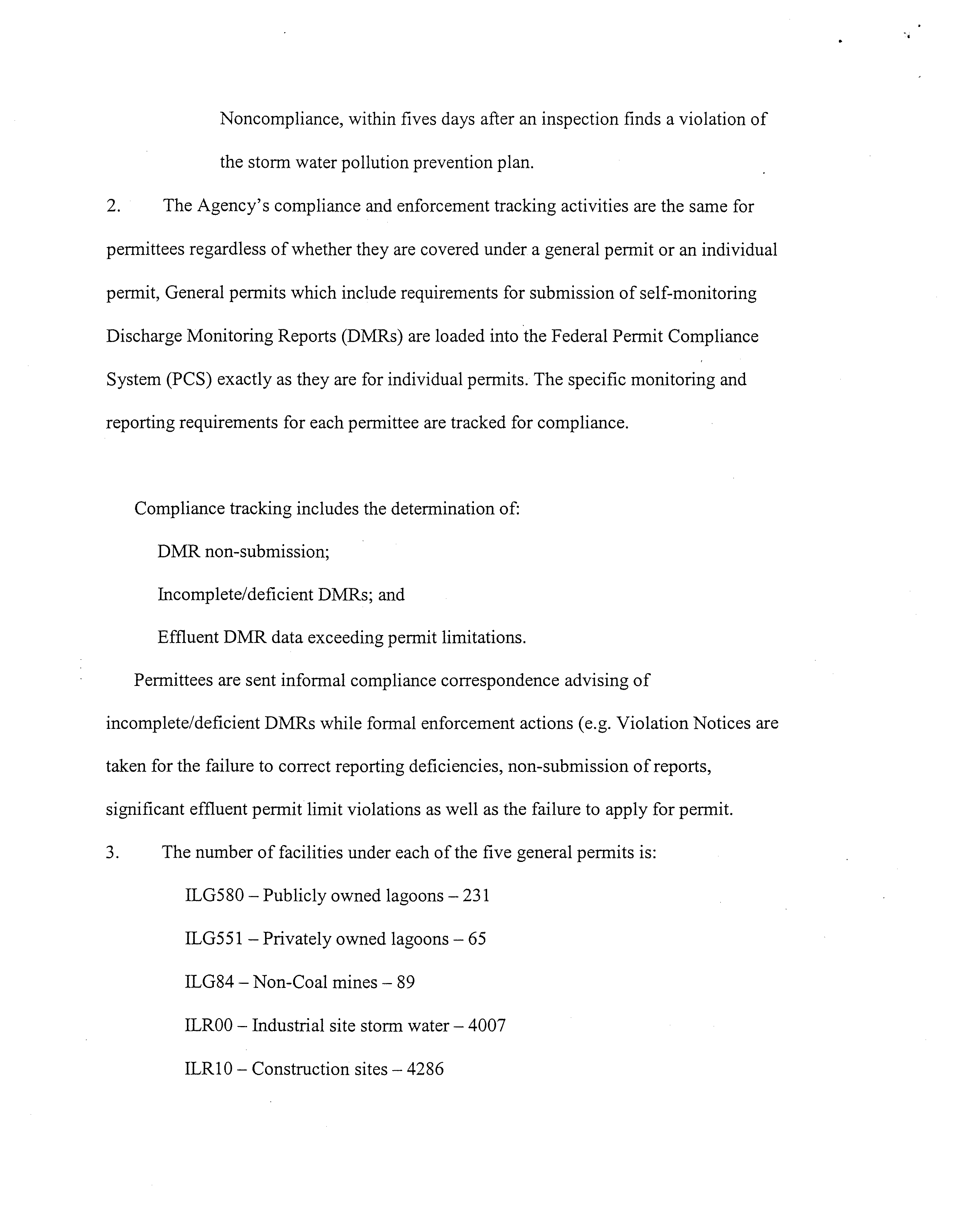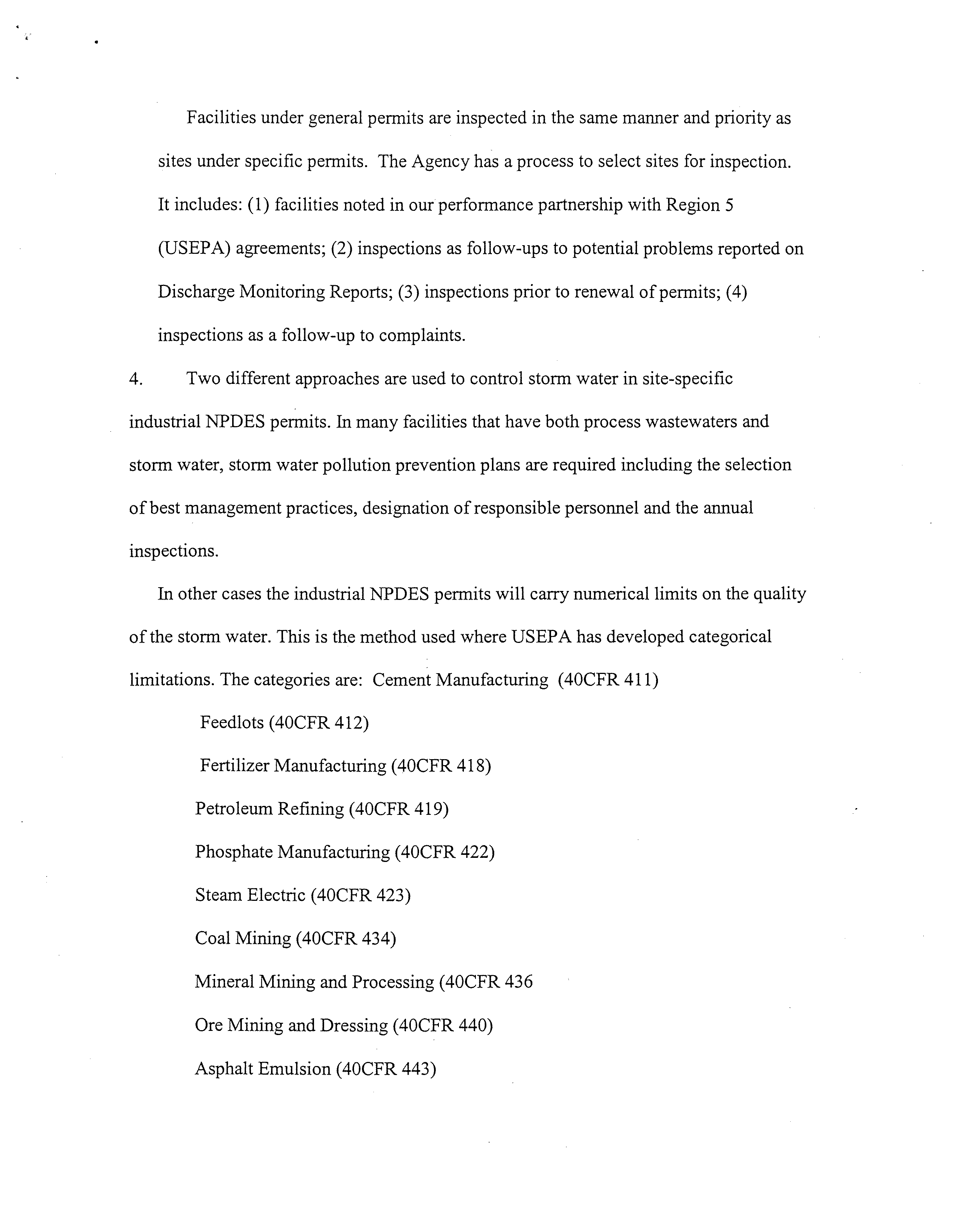BEFORE THE ILLINOIS POLLUTION CONTROL BOARD
IN THE MATTER OF:
)
AMENDMENTS TO 35111. Adm. Code
)
R01-13
302.105; and
)
(Rulemaking)
PROPOSED 35 Iii. Adm. Code 303.205, 303.206
)
and 35 Ill. Adm. Code 106.990 through
106.995.
)
NOTICE OF FILING
Dorothy M. Gunn, Clerk
Illinois Pollution Control Board
James R. Thompson Center
100 West Randolph Street, Suite. 11-500
Chicago, Illinois 60601
Marie E. Tipsord
Hearing Officer
Illinois Pollution Control Board
James R. Thompson Center
100 West Randolph Street
Suite 11-500
Chicago, Illinois 60601
And the Attached Service List
PLEASE
TAKE
NOTICE
that I have today filed with the Office of the Clerk of the Pollution Control
Board the Answers of the Illinois Environmental Protection Agency to Pre-filed Questions, a copy of which is
herewith served upon you.
ENVIRONMENTAL PROTECTION AGENCY
OF THE STATE OF ILLINOIS
By:____
Connie L. Tonsor
Associate Counsel
Division of Legal Counsel
DATED: March 9, 2001
Illinois Environmental Protection Agency
1021 North Grand Avenue East
Post Office Box 19276
Springfield, Illinois 62794-9276
(217) 782-5544
THIS FILING IS SUBMITTED ON RECYCLED PAPER
BEFORE THE
ILLINOIS POLLUTION CONTROL BOARD
IN THE MATTER OF:
)
)
REVISIONS TO ANTIDEGRADATION
)
R01-13
RULES: 35 ILL. ADM. CODE 302.105,
)
(Rulemaking-Water)
303.205, 303.206, and
106.990-106.995
)
)
Illinois Environmental Protection Agency’s Answers to Pre-filed Questions
1.
There are currently five general permits in place. Two ofthem are similar with
oniy the ownership of the facilitybeing the distinguishing difference. The permits are:
A)
ILG58O
—
This permit covers the discharges from publicly owned lagoon
systems with a single pipe discharge serving less than 2500 population.
The facilitymust have had a previous permit. The permit limits
carbonaceous biochemical oxygen demand, suspended solids and pH.
Weekly monitoring offlow is required as a minimum, Monthly
monitoring for CBOD, suspended solids and pH is required. Monthly
submission ofdischarge monitoring reports is required.
B)
ILG551
—
This permit covers the discharges from privately owned lagoon
systems with a single pipe discharge serving less than 2500 population.
The facility must have had a previous permit. The permit limits
carbonaceous biochemical oxygen demand, suspended solids and pH.
Weekly monitoring offlow is required as a minimum. Monthly
monitoring for CBOD, suspended solids and pH is required. Monthly
submission of discharge monitoring reports is required.
C)
ILG84
—
This permit covers the discharges from non-coal mines. These
facilities produce crushed stone, construction sand and gravel, and
industrial sands. The permit limits suspended solids and pH. Monthly
monitoring of flow, suspended solids and pH is required. Monthly
submission of discharge monitoring reports is required.
D)
ILROO
—
This permit covers the discharge ofstorm water from industrial
property identified by Phase I ofthe USEPA regulations. The permit
requires the development of a storm water pollution prevention plan,
which identifies the best management plans selected forthe site and the
responsible company personnel. The permit requires an annual inspection
ofthe site to determine if the best management plans are being
implemented. The permit requires an annual submission ofthe inspection
reports.
E)
ILR1 0
—
This permit covers the discharge ofstorm water from
construction sites offive acres or larger. The permit requires the
development of a storm waterpollution prevention plan, which identifies
the best management practices selected for the site and the responsible
personnel. The permit requires weekly inspections by the responsible
personnel ofthe site and additional inspections afler each rainfall in excess
of 0.5 inches. The permit requires the submission of a report, Incidence of
Noncompliance, within fives days after an inspection finds a violation of
the storm water pollution prevention plan.
2.
The Agency’s compliance and enforcement tracking activities are the same for
permittees regardless ofwhether they are covered under a general permit or an individual
permit, General permits which include requirements for submission ofself-monitoring
Discharge Monitoring Reports (DMR5) are loaded into the Federal Permit Compliance
System (PCS) exactly as they are for individual permits. The specific monitoring and
reporting requirements for each permittee are tracked for compliance.
Compliance tracking includes the determination of:
DMR non-submission;
Incomplete/deficient DMRs; and
Effluent DMR data exceeding permit limitations.
Permittees are sent informal compliance correspondence advising of
incomplete/deficient DMRs while formal enforcement actions (e.g. Violation Notices are
taken for the failure to correct reporting deficiencies, non-submission ofreports,
significant effluent permit limit violations as well as the failure to apply forpermit.
3.
The number of facilities under each ofthe five general permits is:
ILG58O
—
Publicly owned lagoons
—
231
ILG551
—
Privately owned lagoons
—
65
ILG84
—
Non-Coal mines —89
ILROO
—
Industrial site storm water
—
4007
ILR1O
—
Construction sites
—
4286
Facilities under general permits are inspected in the same manner and priority as
sites under specific permits. The Agency has a process to select sites for inspection.
It includes: (1) facilities noted in ourperformance partnership with Region 5
(USEPA) agreements; (2) inspections as follow-ups to potential problems reported on
Discharge Monitoring Reports; (3) inspections prior to renewal ofpermits; (4)
inspections as a follow-up to complaints.
4.
Two different approaches are used to control storm water in site-specific
industrial NTPDES permits. In many facilities that have both process wastewaters and
storm water, storm water pollution prevention plans are required including the selection
ofbest management practices, designation ofresponsible personnel and the annual
inspections.
In other cases the industrial NPDES permits will carry numerical limits on the quality
ofthe storm water. This is the method used where USEPA has developed categorical
limitations. The categories are: Cement Manufacturing (4OCFR 411)
Feedlots (4OCFR 412)
Fertilizer Manufacturing (4OCFR 418)
Petroleum Refining (4OCFR 419)
Phosphate Manufacturing (4OCFR 422)
Steam Electric (4OCFR 423)
Coal Mining (4OCFR 434)
Mineral Mining and Processing (4OCFR 436
Ore Mining and Dressing (4OCFR 440)
Asphalt Emulsion (4OCFR 443)
Site-specific permits can also be required to carry numerical limitations when
Pollution Control Board regulations require them, as for runoff from landfills.
5.
The Agency requires all facilities to monitor the operation and performance ofthe
Storm Water Pollution Prevention Plan. Only the NPDES permits that have placed
numerical limits on the storm water quality will require discharge monitoring in the form
of chemical analysis. The parameters to be monitored will be established by the
categorical standard or the Pollution Control Board regulations. The most common
parameters are suspended solids, oil and grease and pH.
6.
The Agency reviews the storm water pollution control plans required by general
NPDES permit ILR1 0 during inspections or as part of a review of a compliance
commitment plan submitted in response to a notice of violation. Local and regional
authorities also inspect construction sites subject to ILR1 0.
7.
The Agency reviews the storm water pollution prevention plan required by
general NPDES permit ILROO during the review of a compliance commitment plan
submitted in response to a notice ofviolation.
8.
The Agency conducts inspections ofsites discharging under the two general
permits. The permits require that the storm water pollution prevention plans be
maintained on site. The Agency will ask to see them during the inspections.
9.
The Agency has issued 176 individual permits that require the development of
storm water pollution prevention plans.
10.
Since Questions 10 and 11 involve similar issues the Agency has addressed both
questions in its Answer 10. The Agency does not have a count on the number ofstorm
waterpollution prevention plans in our files. The emphasis ofthe storm water program is
that the plan be consulted routinely during the operation of the permitted facility or the
conduct of the activity. Therefore, these plans are required to be on site. The Agency
does not review and approve storm water pollution prevention plans as an ongoing
function of the permit program. See the responses to Questions 6. and 7 which address
those circumstances under which the storm water pollution prevention plans are
reviewed.
12.
The Agency has previously addressed this question in prior testimony. It does not
feel that it has the resources to conduct a study of currentload allocations.
13.
The Agency follows USEPA guidance on the determination ofreasonable
potential as contained in Technical Support Document for Water Quality-based Toxics
Control, EPAI5O5/2-90-001, March 1991.
)
STATE OF ILLINOIS
COUNTY OF SANGAMON
)
)
SS
)
)
PROOF OF SERVICE
I, the undersigned, on oath state that I have served the attached
Illinois EPA Answers to Pre-filed Questions,
and Notice upon the person to whom it is directed, by placing a copy in an envelope addressed to:
Dorothy Gunn
Clerk, Pollution Control Board
100 West Randolph, Suite 11-500
Chicago, Illinois 60601
(FIRST CLASS MAIL)
Marie Tipsord
Attorney, Pollution Control Board
100 West Randolph, Suite 11-500
Chicago, Illinois 60601
(FIRST
CLASS MAIL)
Kay Anderson
American Bottoms RWTF
One American Bottoms Road
Sauget, Illinois 62201
(FIRST CLASS MAIL)
Fredric P. Andes
Barnes & Thomburg
2600 Chase Plaza, 10
S. LaSalle Street
Chicago, Illinois 60603
(FIRST CLASS MAIL)
Karen L. Bernoteit
IL Environmental Regulatory Group
215 E. Adams St.
Springfield, Illinois 62701-1199
(FIRST CLASS MAIL)
Chris Bianco
Chemical Industry Council
9801 W. Higgins Road, Suite
515
Rosemont, Illinois 60018
(FIRST CLASS MAIL)
Christine Bucko
AAG
188 W. Randolph, 20th Floor
Chicago, Illinois 60601
(FIRST CLASS MAIL)
Jack
Darin
Sierra Club, Illinois Chapter
200 N. Michigan, Suite
505
Chicago, Illinois 60601
(FIRST CLASS MAIL)
Albert Ettinger
Environmental Law & Policy Center
35
E. Wacker Drive, Suite 1300
Chicago, Illinois 60601-2110
(FIRST CLASS MAIL)
Susan M. Franzetti
Sonnenschein Nath & Rosenthal
8000 Sears Tower, 233 South Wacker Drive
Chicago, Illinois 60606
~)
?~i273O
Ofl~~~_j —-
Bank One Plaza, 10 So. Dearborn St.
Chicago, Illinois 60603
(FIRST CLASS MAIL)
Katherine Hodge
Hodge & Dwyer
3150 Roland Ave., P0 Box 5776
Springfield, Illinois 62705-5776
(FIRST CLASS MAIL)
Richard J. Kissel
Gardner, Carton & Douglas
321 N. Clark Street, Suite 3400
Chicago, Illinois 60610
(FIRST CLASS MAIL)
Page 1 of2
THIS FILING IS SUBMITI’ED ON RECYCLED PAPER
Sharon Neal
CornEd
—
Unicorn
Law Dept. 125 S. Clark St.
Chicago, Illinois 60603
(FIRST CLASS MAIL)
Jerry Paulson
McHenry County Defenders
804 Reginact
Woodstock, Illinois 60098
(FIRST CLASS MAIL)
Irwin Polls
Metropolitan Water Reclamation
Environmental Monitoring, 600 1W. Pershing Road
Cicero, Illinois 60804-4112
(FIRST CLASS MAIL)
Cindy Skrudkrud
4209 W. Solon Road
Richmond, Illinois 60071
(FIRST CLASS MAIL)
Georgia Viahos
Dept of the Navy
Naval Training Center, 2601A Paul Jones Street
Great Lakes, Illinois 60088-2845
(FIRST CLASS MAIL)
Charles Wesselhoft
Ross
&
Hardies
150 North Michigan, Suite 2500
Chicago, Illinois 60601
(FIRST CLASS MAIL)
Stanley Yonkauski
IL.
Department ofNatural Resources
524 South Second Street
Springfield, Illinois 62701
(FIRST CLASS MAIL)
and mailing it from Springfield, Illinois on February 2, 2001 with sufficient postage affixed as indicated above.
SUBSCRIBED AND SWORN TO BEFORE ME
(~~7~7L~
this 2 day of February, 2001.
Notaiy Public
OFFICIAL SEAL
BRENDA BOEHNER
NOTARY PUBUC, STATE OF ILLINOIS
:~:MYCOMMISSION EXPIRES 11.14-2001
Page 2 of2
THIS FILING IS SUBMIrr’ED ON RECYCLED PAPER










